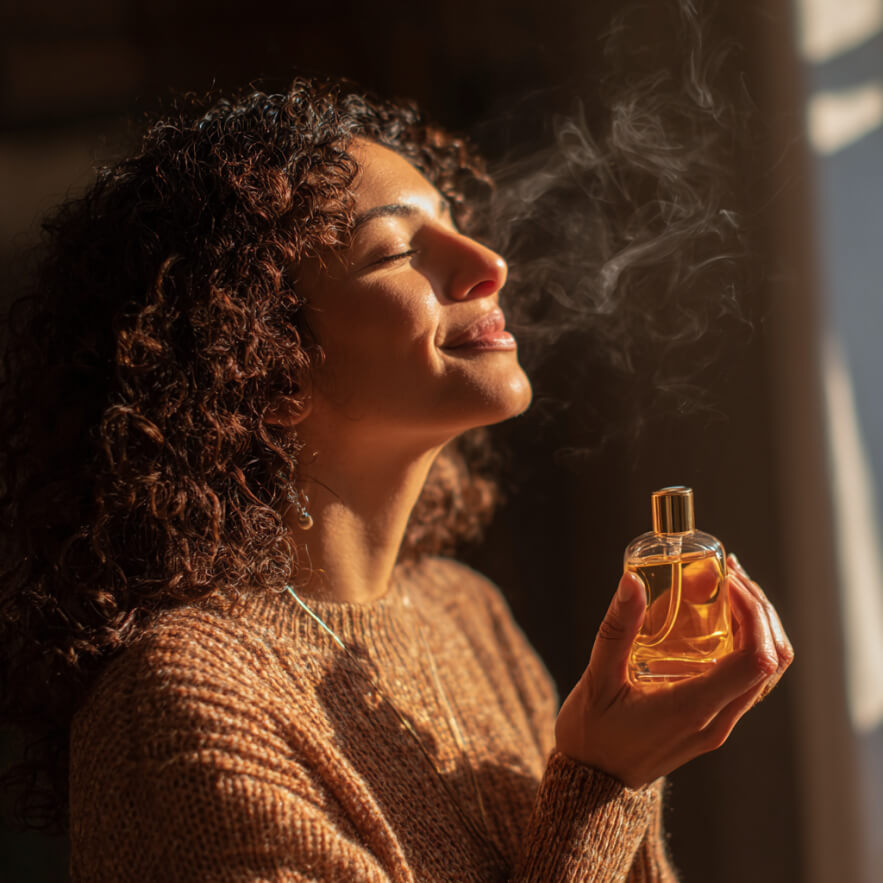The same fragrance can wear a different face. Anyone who’s tested a perfume in-store and then worn it knows: skin changes the scent. This isn’t magic or marketing — it’s the interaction between the skin’s microbiome, body temperature, and fragrance molecules. Finding a perfume that truly merges with your skin is less about shopping, more about discovery. Increasingly, this search feels like an exploration of one’s own nature.
What affects how perfume unfolds on your skin
Skin isn’t a neutral platform — it’s a living organ with unique chemistry. It’s influenced not just by type (dry, oily, combination), but also by pH levels, hormone balance, diet, medications, stress, and even the weather. All of this impacts how fragrance notes develop — which ones bloom, which ones fade, and which ones distort.
Perfumers pay close attention to the skin’s microbiota. Every person carries a distinct bacterial profile that affects how aroma molecules break down. On one person, musk becomes warm and powdery. On another — soapy or even sharp. Spices, leather, and oud can either turn muddy or become incredibly nuanced. So, perfume is always a duet between the scent and the wearer.
Professionals suggest applying perfume to more than just wrists or neck. Less obvious areas — the inside of the elbow, behind the ear, even the stomach — have different temperatures and moisture levels that affect the dry-down. This reveals the fragrance in motion — it can feel like a different perfume from morning to evening.To test how a scent behaves for you, apply it to bare, clean skin, without lotions or oils. And wait — at least 2–3 hours. First impressions can deceive. Base notes, which last the longest, don’t show themselves right away.
Why choosing by scent in the air can be misleading
A common mistake is testing perfume only on blotters. It’s convenient, but it reveals little about how a fragrance behaves on skin. Perfume molecules act differently when interacting with warmth, sweat, or a person’s natural odor. This is especially true for amber, leather, and aldehyde accords.
There’s even a term — skin scent — meaning a perfume that only comes to life on skin, remaining nearly invisible in the air. These scents aren’t meant to project — they’re meant to become an intimate layer of self. On paper, they vanish. On skin, they thrive.
Skin can also amplify or mute certain ingredients. For example, a diet rich in spices can sharpen notes like musk or tobacco. Taking B vitamins may distort florals. Smoking or the remnants of previously worn perfumes also alter the chemistry.
This is why perfumers advise: if you don’t love a scent on first skin contact, give it a chance to develop. If you fall in love immediately, don’t rush — the dry-down may disappoint. The best test is a full-day wear. Let it live with you, and decide in the evening whether you’d want to smell like this again tomorrow.
How to find “the one” with smarter testing
Fragrance selection shouldn’t be random. It’s about testing with awareness — feeling how the scent moves with your mood, your skin, your day. That’s why many perfume lovers keep scent diaries, recording how the fragrance wore, what feelings it triggered, how others responded.
A popular trick among scent collectors is double testing. Apply the perfume once in the morning, when your body is fresh and warm, and again in the evening when your chemistry shifts. This shows how stable the perfume is and how it adapts to your changing state.
Use decants or samples — full bottles should only come after repeated, thoughtful wear. Many find success with a weekly method: one scent, one week. Only then do you understand if it fits into your routine, your emotions, your daily rhythm.
Also, try wearing the fragrance in varied situations:
- indoors and outdoors
- while active and while resting
- in warmth and coolness
- during emotional highs and lows
This helps assess its adaptability — whether the perfume adjusts to you, not the other way around.
Personalizing by components: what your skin loves
If you want a perfume that sings with your skin, pay attention to how certain note families behave. Musk and sandalwood are relatively stable — if they feel natural on you, they’re a strong foundation. Jasmine, lily of the valley, and aldehydes are more volatile — they demand skin testing.
Leather and woody notes bloom beautifully on warm skin, becoming round and sensual. Cooler skin might sharpen green and citrus notes, creating a more crisp result. This matters when choosing a signature scent you’ll wear daily.
Skin can also enhance a perfume’s emotional tone. Some people notice that a scent feels bolder or darker on them than on friends. This isn’t subjective — molecules interact with your unique biome to produce nuances that don’t exist in the bottle or on a strip.Many perfumers recommend starting with simple compositions — perfumes with just a few notes — to isolate how your skin treats each one. Once you know how your skin handles amber, incense, or fig, you can move to more layered and complex formulas with confidence.
Tips from perfumers: how to “tame” your fragrance
Once you’ve found your perfume, the next stage begins — making it yours. This is not poetic fluff. A true match needs adaptation and care. Application technique, storage, and dosage all matter.
Here’s what master perfumers recommend:
- Apply on skin, not clothes. Fabric alters the scent and blocks your skin’s chemistry from working.
- Use on moisturized skin. A lightly hydrated surface (with unscented cream) helps fragrance cling and last longer.
- Avoid rubbing. Rubbing wrists breaks down top notes and alters the fragrance structure.
- Keep bottles away from heat and light. Even luxury packaging can’t protect ingredients from degradation.
- Go easy. One drop can often speak louder than a cloud of spray.
True harmony between scent and skin comes from balance and awareness. If the perfume feels like an extension of your body — you’ve made it your own.
Skin as co-creator: when perfume becomes your signature
The longest-lasting perfumes in your collection aren’t necessarily the strongest. They’re the ones that feel like you. People around you start to recognize the scent as part of your presence — your personal accord — even if they don’t know the name.
Some perfumers admit they don’t aim for bold effects, but for skin fusion — scents that blend, not shout. They test their formulas on a variety of skin types to see how the perfume lives. This isn’t about selling a bottle — it’s about crafting an extension of the self.
If a scent disappears on your skin but others still smell it hours later — you’ve struck gold. That’s a true skin scent, the kind that bonds with you silently but lingers for others to notice.Curious how emotions shape scent preferences? Read Scent of mood: perfume you choose with your heart, not just your nose — it explores the deep connection between feeling and fragrance.
If it wears softly, doesn’t irritate or overwhelm you, and still feels pleasant by the end of the day — chances are, it’s your match.
Absolutely. Temperature and moisture vary by zone, making a scent feel richer behind the ear and sharper on the wrist.
Not at all. Use samples or decants and wear the fragrance over several days and conditions to be sure it’s right for you.

